Most people would be able to answer carbohydrate, protein, fat and vitamins if they were asked to list the nutrients in our food. But fibre is also an important nutrient that often is forgotten and therefore is one that we don’t tend to get enough of. (1) Adults need around 25-30g of a variety of fibres each day for good health. (2) Luckily the different types of fibre are found in a wide range of wholefoods, so eating a varied diet will be your best bet for obtaining the whole body health benefits of fibre, such as reducing the risk of certain types of cancers and diabetes, protecting heart health and optimising bowel and gut health. (3)
Let’s look at the different types of fibre found in food and five ways to get more fibre in your diet each day.
What are the different types of fibre found in food?
Soluble Fibre
Soluble fibre gets its name because it dissolves and thickens into a gel when it comes in contact with water. This means that food moves through the digestive system slower, which can help to lower cholesterol and help regulate blood glucose levels. (3) Soluble fibre is found in the fleshy parts of fruit and vegetables, seeds, nuts, lentils, oats, barley, psyllium, lentils and legumes.
Insoluble Fibre
You might know insoluble fibre better by the name ‘roughage’. It is generally resistant to fermentation in the large intestine and helps bulk up and soften stools thereby assisting with regular bowel movements. (3) Insoluble fibre is found in the skins and seeds of fruit and vegetables, quinoa, wholegrains, millet and brown rice, as well as foods made with high-fibre ingredients such as cereals and wholemeal/wholegrain breads.
Resistant Starch
Firm bananas, wholegrains, legumes all contain resistant starch. When rice, potatoes and pasta have been cooked and cooled, they also create resistant starch. Resistant starch is the name given to fibre that is not digested in the small intestine but travels into the large intestine where it is fermented by good bacteria which help keeps the large intestine healthy and may protect against bowel cancer. (3) This video from the CSIRO provides a great visual on how resistant starch benefits our gut microbiome and protect against cancer.
How to get more fibre from wholefoods
- Fruit
Fruit is a source of fibre, just make sure you eat the skins on fruit (where appropriate of course – no one likes eating banana skin!) to get the insoluble fibre along with the soluble fibre of the flesh.
- Vegetables
If fruit contains fibre, then it is not surprising that vegetables are also great sources of fibre. Depending on the type of vegetable and how it has been cooked, vegetables contain soluble and insoluble fibre as well as resistant starch. Again, leaving the skins on veggies is a great way to boost the amount of fibre eaten.
- Grains
Grains generally contain insoluble fibre and resistant starch and include wheat, oats, rice, corn, barley, sorghum, rye, millet, spelt, freekeh, farro, kamut, amaranth, buckwheat and quinoa.
All of the products in the Alpine range are a source of dietary fibre with the Spelt & Sprouted Grains and Tuscany Grain being good sources of dietary fibre (contains more than 4g per serve) and our Super Natural Protein bread being an excellent source of dietary fibre (contains more than 7g per serve).
- Legumes
Legumes include foods such as chickpeas, lentils, mung beans, peanuts, tempeh, tofu, peas, soya beans, black beans, broad beans and baked beans. If you are following a low FODMAP diet, make sure you check your types of legumes and portion sizes carefully to ensure that you get the benefits of fibre without upsetting your tummy.
- Nuts
Nuts make great snacks and therefore are an easy way to quickly increase your daily fibre intake. You also get the added bonus of healthy fats, protein, and phytochemicals (these are plant chemicals that have protective or disease preventive properties). Like legumes, make sure you check your types and portion sizes if you are following a low FODMAP diet.
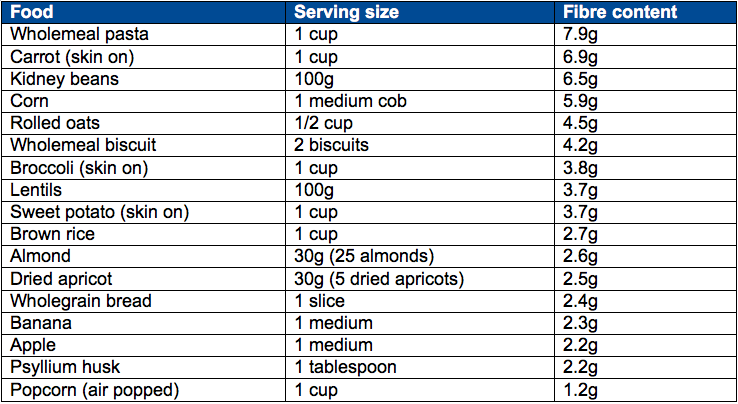
Table courtesy of Nutrition Australia
By eating a wide range of wholefoods every day, hitting that daily fibre intake is possible, along with all of the fantastic health benefits dietary fibre provides.
How do you get your fibre?
We’d love to hear from you so let us know in the comments section or send an email to our dietitian at info@alpinebreads.com.au
- Australian Bureau of Statistics (2014) 4364.0.55.007 – Australian Health Survey: Nutrition First Results – Foods and Nutrients, 2011-12
- Nutrient Reference Values for Australia and New Zealand. Canberra: Commonwealth of Australia, 2006
- Anderson JW, Baird P, Davis Jr RH, Ferreri S, Knudtson M, Koraym A, Waters V, Williams CL (2009) Health benefits of dietary fibre, Nut Rev; 67(4): 188-205
- World Cancer Research Fund International, 2016. Summary of strong evidence on diet, nutrition,
Physical activity and prevention of cancer. http://www.wcrf.org/sites/default/files/WCRFI-Matrix-for-all-cancers.pdf
The low FODMAP diet is a diet that was developed by an Accredited Practising Dietitian to help people manage their symptoms of Irritable Bowel Syndrome. It has also been extensively researched by scientists, so there is a lot of evidence to support its effectiveness. However, that hasn’t prevented people from misunderstanding what the diet involves and making up their own ‘rules’ or beliefs about it. So here are five of the more common myths about the low FODMAP diet…busted!
At Alpine, we love our grains and our breads are packed full of them. But as well as making our bread taste extra good and give them great texture, did you know that they are also little nutrition powerhouses? Here’s why we think grains are so great.
Note that the information here is of a general nature only. It has not been tailored for the low FODMAP or gluten free diets.
Beginning a low FODMAP diet (the elimination phase) can be extremely daunting. The fact that it is called an ‘elimination’ phase suggests that there will be lots of food restriction. Not to mention that there is a LOT of information around telling you what you can and can’t eat during this phase. It can be tricky to know which information to trust. Everything can feel very overwhelming and leave you wondering if all you are going to be able to live on is air and water!
Rather than focus on foods that you CAN’T eat, here are 9 foods that you might not have known you CAN eat during the elimination phase. All of the foods are considered to be low FODMAP based on the information found in the Monash University Low FODMAP app1. This app contains the most up to date information on foods suitable on the low FODMAP diet based on the research being done by Monash University. You should always refer to the app for the appropriate portion sizes of each food, as the amount of each food you eat is important during the elimination phase.
- Fruit
Even though they are nature’s sweet treat, unfortunately some fruit are high in FODMAPs and need to be restricted during the elimination phase. But there are a lot of fruits that can still be enjoyed; it is just a matter of referring to your app and making sure you are choosing a suitable variety and a suitable portion size. Some low FODMAP fruits include:
- Kiwi fruit
- Banana
- Grapes
- Strawberries
- Orange
- Mandarin
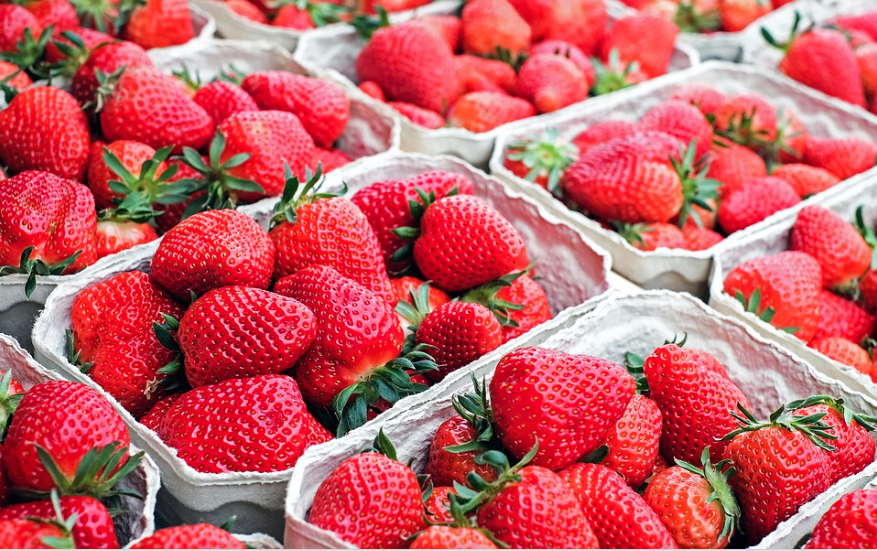
- Dairy
A low FODMAP diet is not the same as a dairy free diet. During the elimination phase, it is only lactose that needs to be reduced, not dairy altogether. There are lactose free milks and yoghurts available in most supermarkets, making it much easier to just swap brands. And you may not know that some cheeses are also low in lactose and therefore suitable during the elimination phase. These include cheddar, pecorino, swiss and mozzarella.
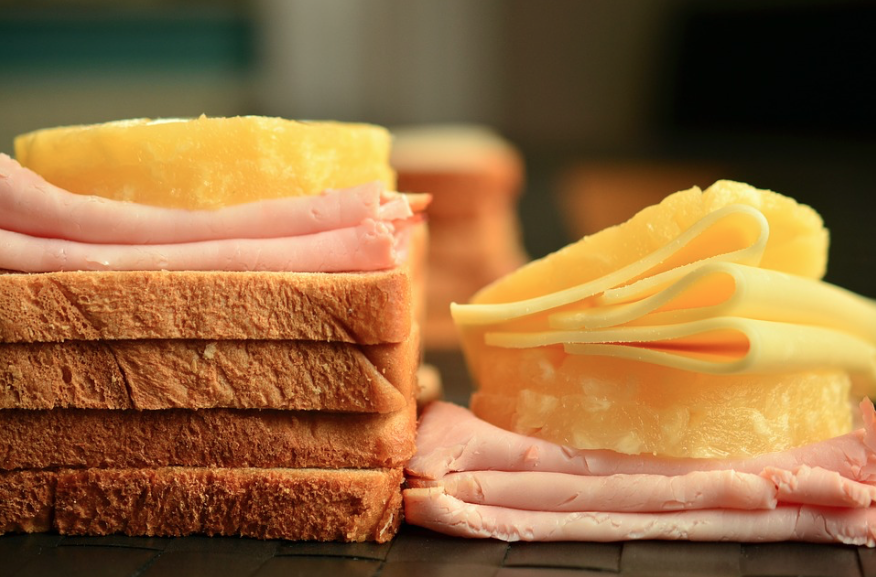
- Gluten
The low FODMAP diet is not a gluten free diet. Oligosaccharides, specifically oligos-fructans are the type of carbohydrate that can cause gastrointestinal symptoms in people with irritable bowel syndrome and are found in wheat, barley and rye. A gluten free diet however, aims to exclude the gluten protein, which causes gastrointestinal damage and symptoms in people diagnosed with coeliac disease. Gluten is also found in wheat, barley and rye, which is why there is so much confusion around gluten! So for example, while oats cannot be eaten on a gluten free diet, oats are allowed during the elimination phase of a low FODMAP diet. Spelt flour is another example of a food that must be eliminated on a gluten free diet, but is suitable on a low FODMAP diet.
- Bread
So having said that a low FODMAP diet is not the same as a gluten free diet, it means that bread is food that can still be enjoyed on a low FODMAP diet (yay!). You just need to make sure you choose bread that is low in FODMAPs. The Alpine range contains three varieties that have been FODMAP friendly certified and are suitable even during the elimination phase. These are the Sour Rye, Spelt & Barley and Spelt & Sprouted Grains.
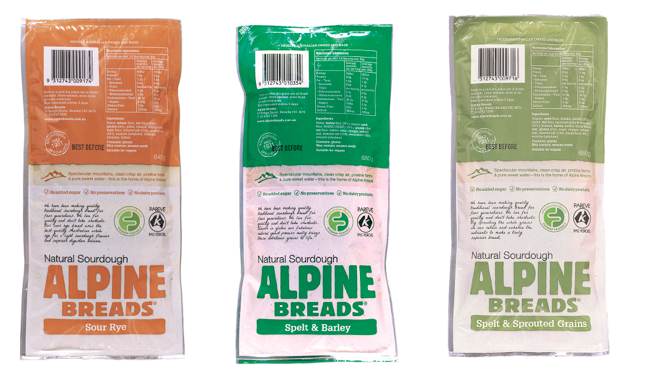
- Garlic
This one is a little bit tricky, because garlic cloves are actually high in FODMAPs and need to be avoided during the elimination stage. But using a garlic infused oil, or frying some garlic cloves in oil for a couple of minutes to transfer the flavour and then removing the cloves before cooking the next part of your meal is ok. This is because FODMAPs do not leach into the oil, so all you get is the lovely flavour and not the tummy trouble!
- Onion
Onions are much like garlic. You can use an infused oil or sauté some onion in oil and then remove it prior to cooking the rest of your meal in order to get that onion flavour into your cooking. You can also replace the onion altogether with chives or the green part of spring onion and leeks (the white part of spring onion and leeks are high in FODMAPs, so make sure you only use the brightest green top part).
- Nuts
Nuts are an excellent addition to an overall healthy diet and luckily there are many varieties that can still be included during the elimination phase of a low FODMAP diet.
The following are considered low FODMAP and should be tolerated by most people:
- Chestnuts
- Peanuts
- Hazelnuts
- Macadamia nuts
- Brazil nuts
- Pecans
- Pine nuts
- Walnut
- Almonds
Nuts to avoid: cashews, pistachios
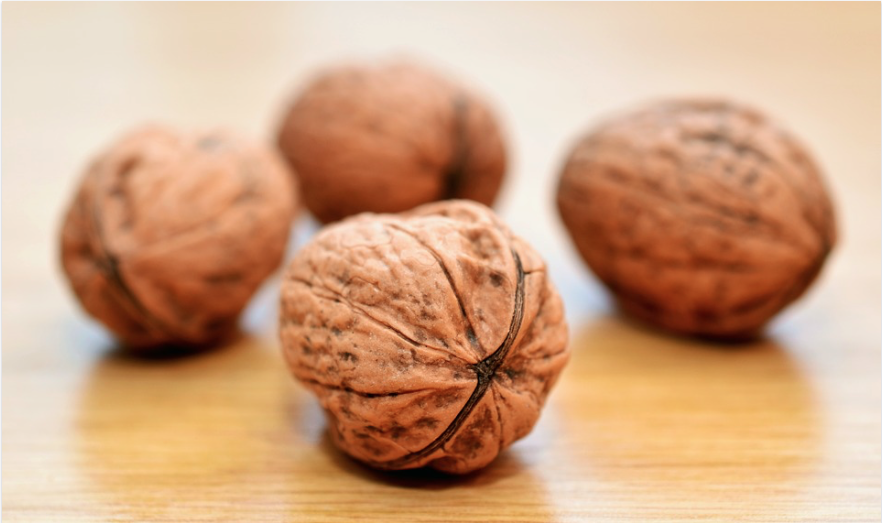
- Legumes and pulses
Legumes and pulses are notorious for causing bloating and wind in almost everyone, but are particularly problematic for people with irritable bowel syndrome2. So it is easy to assume that they need to be cut out altogether when starting out on a low FODMAP diet, but fortunately this is not the case.
The following are considered low FODMAP and should be tolerated by most people:
- Canned chickpeas
- Canned lentils
- Boiled mung beans
- Plain, firm tofu
- Plain tempeh
- Peanut butter
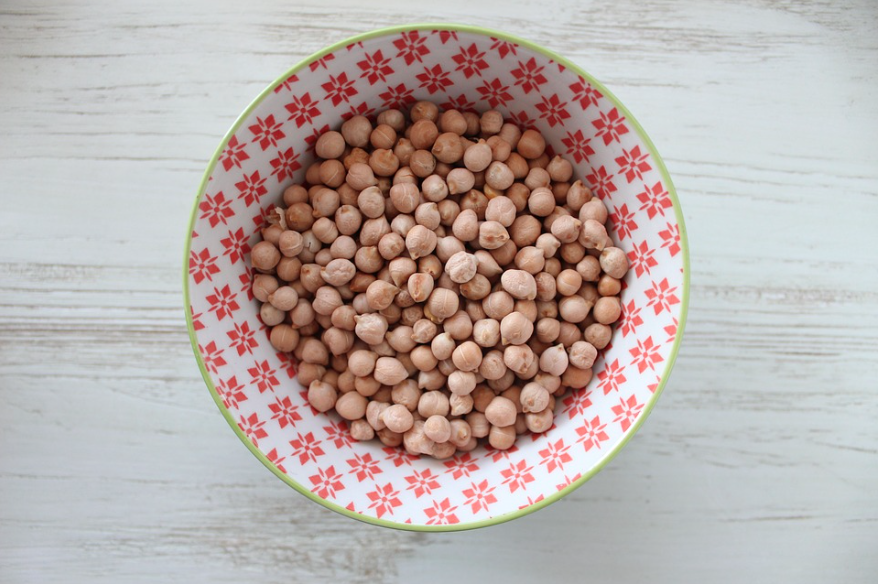
Legumes and pulses like peas, soya beans, black beans, broad beans and baked beans are high FODMAP, so it is a good idea to always refer to the Monash University low FODMAP app to double check which legumes and pulses (and the appropriate serving sizes) are suitable.
- Sugar
This one might seem a bit controversial given the public health messages to reduce the amount of sugar in your diet3, but these sweet granules are actually low FODMAP and can be a useful way to ensure weight maintenance if your elimination phase (and subsequent reintroduction phase) is extremely restrictive. For example, swapping honey (high FODMAP) for some brown sugar or maple syrup is an easy way to keep enjoying your porridge.
So whilst beginning a low FODMAP diet will mean making a number of changes to what you might be used to eating; hopefully you can see that there are a variety of foods you can still safely enjoy during the elimination phase. To make sure you are eating the appropriate foods for your individual needs, it is important to seek advice from an Accredited Practising Dietitian (APD) before commencing the elimination phase. You can find a dietitian who specialises in low FODMAP diets at the Dietitians Association of Australia website.
References:
- Monash University low FODMAP app http://www.med.monash.edu.au/cecs/gastro/fodmap/iphone-app.html
- Dr Jacqui Barrett, 2016. What are the Oligos? http://fodmapmonash.blogspot.com.au/2016/03/what-are-oligos.html
- Eat for Health, 2015. Fat, Salt, Sugars and Alcohol. https://www.eatforhealth.gov.au/food-essentials/fat-salt-sugars-and-alcohol
